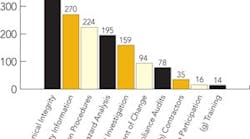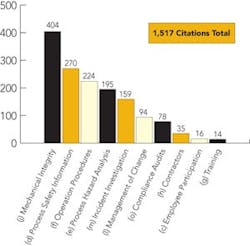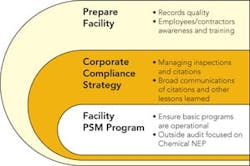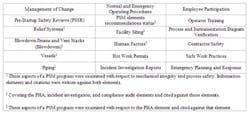Prepare for More Safety Inspections
In June 2007, as a response to the U.S. Chemical Safety and Hazard Investigation Board's report on the explosion at BP's Texas City refinery and in response to statistics that show a high rate of fatalities and serious injuries in the refining industry, the U.S. Occupational Safety and Health Administration (OSHA) issued Directive CPL 03-00-004, "Petroleum Refinery Process Safety Management National Emphasis Program [NEP]." OSHA has now finished, or soon will, inspections of all 81 petroleum refineries under federal jurisdiction. These evaluations emphasize process safety management (PSM) by using a set of specifically targeted questions, many of which reflect issues surrounding the Texas City accident.
On July 27, 2009, OSHA published Directive 09-06 (CPL 02), "PSM Covered Chemical Facilities National Emphasis Program," to extend the Refinery NEP program to chemical industry facilities covered by the PSM Standard (see sidebar). OSHA estimates the Chemical NEP program could run eight years. As with the Refinery NEP, OSHA inspectors likely will arrive unannounced at chemical plants.
Figure 1. Ten elements of the PSM Standard accounted for 98% of findings (through May 2009)
On July 8, 2010, OSHA issued Directive 10-05 (CPL 02), which replaces the pilot program directive that expired on July 27, 2010. This directive extends the pilot program until September 30, 2010 and encourages State Plan adoption as well for those states that aren't under the federal OSHA.
OSHA is implementing the Chemical NEP on a pilot basis in OSHA Region I (ME, VT, CT, RI, NH, MA), Region VII (KS, NE, IA, MO) and Region X (ID, WA, OR, AK) through September 30, 2010. Unprogrammed inspections in response to alleged hazardous working conditions or actual incidents can happen in all OSHA regions and will occur regardless of whether a plant takes part in a Voluntary Protection Program (VPP). More than 15,000 facilities nationwide could face inspections.
OSHA indicates NEP inspections will target certain facilities. It has compiled a list from the approximately 8,000 facilities that have submitted Program 3 Risk Management Plans (RMP) to EPA, facilities that have a NAICS code for manufacturing explosives and facilities from the OSHA IMIS database that have previous PSM-related citations, as well as from local knowledge of industry by OSHA area office personnel.
DYNAMIC INSPECTION PROTOCOL
The Refinery NEP featured a publicly available static list of inspection questions in addition to a dynamic list of questions restricted to OSHA personnel. In contrast, the Chemical NEP will use a dynamic list of questions available only to OSHA personnel. No two facilities are apt to be audited with exactly the same set of questions because only a portion of the dynamic questions will be used. Given the timing of the Refinery and Chemical NEPs, the dynamic Chemical NEP question list likely will include those from the static and dynamic Refinery NEP lists, edited to remove or modify questions that are specific only to oil refineries.
Chemical NEP inspections probably will be more focused and, presumably, briefer than refinery ones. Like in the Refinery NEP, inspections will concentrate more on the implementation of the PSM program, or the lack of it, than on the mere existence of a documented program. In other words, OSHA will examine the program for evidence of a "Say what you do, and do what you say" viewpoint rather than just assessing written policies and procedures for compliance.
The recent OSHA Directive 09-06 (CPL-02) indicates the Chemical NEP, like the Refinery one, will focus on the following PSM elements:
• mechanical integrity;
• operating procedures;
• management of change (MOC);
• pre-startup safety review; and
• contractor safety.
The Refinery NEP also concentrated on Process Hazard Analysis (PHA), as indicated by the citations issued; this likely will also be true for the Chemical NEP.
Facilities that only store highly hazardous chemicals will be inspected using all questions from the PSM general dynamic list. OSHA has generated process-specific lists for ammonia refrigeration, water and wastewater treatment, chemical processing, and other categories of processes.
CONDUCTING THE INSPECTION
During the Refinery NEP, OSHA selected a specific process unit to focus the NEP inspection. It likely will do the same while implementing Chemical NEP inspections. However, inspectors may expand the evaluation if they feel issues extend to other units. The program also includes inspection of contractors and subcontractors performing work at the facility.
The inspection will examine PSM systems in place, even though for many PSM elements the PSM Standard doesn't explicitly require these systems. For example, OSHA inspectors likely will review the mechanical integrity (MI) system for managing inspections and tests of equipment, including handling of late and overdue inspections, selection of inspection frequencies, the approval process for modifications to frequencies, etc., despite the standard not specifically mandating such a MI management system.
OSHA also will examine the interrelationship between process safety elements and will audit the flow of information among these elements. For example, a valve change may impact MOC, MI, process safety information and PHA, and that change should appear in the procedures and records associated with every affected element. To ensure all PSM systems/elements are being fully implemented, inspectors will consider citing all applicable violations in different PSM elements.
As with the Refinery NEP, and as is typical with OSHA enforcement practices, inspectors also can generate citations for alleged violations of general OSHA standards, such as lockout/tagout, hazard communication, confined space, etc., if deficiencies are found during the Chemical NEP inspection. This is typical OSHA enforcement practice. Roughly 25% of the Refinery NEP citations were for non-PSM, occupational safety issues.
One issue that OSHA has had to address is a lack of staff capable of conducting PSM inspections. Most Compliance Safety and Health Officers (CSHO) have health (industrial hygiene) or occupational safety expertise. While inspectors will have completed basic PSM training prior to conducting NEP visits, few have the technical training and background to effectively evaluate complex PSM programs. Very few CSHOs are engineers or have operations experience in the chemical industry. To address this issue, OSHA has embarked on a major effort to train its CSHOs in PSM. A high percentage of the approximately 1,000 CSHOs have been trained to date and more training will be needed to implement the Chemical NEP on a significant scale. It's important to note that federal OSHA and its directives only apply to 29 of 50 states; the remainder operate State Plans and are encouraged, but not required, to implement the federal Chemical Facility PSM National Emphasis Program.
LESSONS LEARNED AND RECOMMENDATIONS
Because many of the dynamic list questions used in the Chemical NEP likely will come from the Refinery NEP static and dynamic list questions, chemical facilities can learn from the past three years of OSHA enforcement in the refinery sector. OSHA has focused on the areas identified in Table 1.
Through May 2009, OSHA has issued 1,517 citations resulting from the Refinery NEP. Approximately 98% of these related to ten elements of the standard (Figure 1). Approximately 75% of the citations were against specific sub-elements, (Table 2). The Refinery NEP citations represent approximately $4.7 million in initial fines. The Chemical NEP probably will focus on similar aspects of PSM programs, at least initially, until citation trends in the chemical sector are established and the dynamic question list is adjusted to account for those trends.
Because it's unlikely a site's triennial compliance audits went deep enough to examine the same issues covered in Chemical NEP inspections, we encourage facilities subject to the program to use a multipronged preparation strategy (Figure 2). The core of the approach is to ensure the facility PSM program is operational. An outside audit of the program, focusing on NEP aspects, may be helpful. The next layer of preparedness is to coordinate with internal affiliates and corporate offices to achieve a common approach to managing Chemical NEP inspections. This strategic approach also should involve developing a standardized system to manage any citations issued during the Chemical NEP, including internally communicating findings to reduce potential for the same citations being given at affiliate facilities. The last layer is to prepare the facility. Inform personnel — full-time employees and contract personnel — who either may be interviewed during an inspection or otherwise interface with the inspector. Ensure facility records related to PSM are in order and easily accessible during an inspection, and that the facility itself has its PSM program in order. Preparation for the Chemical NEP is key not only to possibly reducing regulatory liability but also to helping ensure a safe and productive workplace for all employees.
Which facilities are affected?
Programmed OSHA Chemical NEP inspections will target facilities that store, process or otherwise handle:
• anhydrous ammonia as a refrigerant or for other purposes;
• chlorine for water treatment or other services; or
• other highly hazardous chemicals.
A variety of facilities are excluded from such programmed inspections. These include:
• refineries (NAICS code 32411);
• chemical facilities in Voluntary Protection Programs; and
• chemical facilities located in state-plan states. (However, these facilities may be subject to state NEP or NEP-like inspections. Industry's experience with the Refinery NEP indicates that some states, such as California, Minnesota, New Mexico, Utah and Wyoming, that implemented an in-state Refinery NEP will choose to implement an in-state Chemical NEP.)
Michael J. Hazzan, PE, is manager, Eastern Business Unit, AcuTech Consulting Group, Princeton, N.J.. Martin R. Rose is a senior principal consultant, AcuTech Consulting Group, McLean, Va. E-mail them at [email protected] and [email protected].






